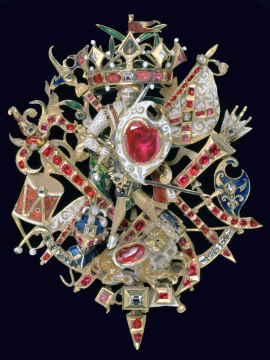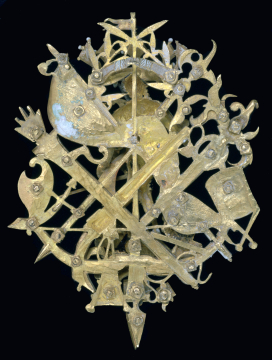Explore Collections


You are here:
CollectionsOnline
/
The 'Naseby Jewel', a cap badge, German, early 17th century
Browse
The 'Naseby Jewel', a cap badge, German, early 17th century
Gold and enamel, set with rubies and diamonds
Height: 90 mm
Width: 65mm
Width: 65mm
Museum number: SDR21.33
Not on display
Curatorial note
This is an exceptional enamelled gold hat jewel set with rubies and diamonds. In the centre is the figure of a cavalier, possibly King Charles I, a bearded man with long hair wearing what may be a Spanish hat with feathers and an upturned brim. He is in complete armour and carries a shield on his arm and an unsheathed sword in his hand, while another sword in its scabbard hangs from his belt. He is surrounded by military trophies and surmounted by a ruby and diamond coronet. The background comprises a Halberd, inset with small rubies, the head partly enamelled in blue and crossed with a standard of St. George in white enamel floral design on gold, with ruby saltire cross with a single diamond at the centre. Below is a sword set with rubies and with one small diamond on the hilt and a quiver of arrows treated in a similar manner. At the base there is a drum in red and white enamel set with a small diamond and a Knight’s helm in blue and white enamel set with small rubies and a single diamond. A lion couchant set with a large ruby is at his feet. In addition to the knightly symbols about the person of the king, the feathers on the helmet (on the ground) seem to be the triple plume of the Princes of Wales. These are surmounted by a sprig of broom, in reference to King Henry II, who is reported to have placed a sprig of broom in his helmet on taking the crusader’s vow. There are also ribbons set with diamonds and rubies. If the back of the jewel is examined a pistol may be seen crossed with the quiver – this is not visible when the jewel is viewed from the front.
Various theories about the origin of this jewel have been put forward, connecting it with Christian IV of Denmark or with James I of England and his son, Charles I (1600-49) who is said to have dropped it when fleeing the battlefield of Naseby in 1645, when his defeat brought the Civil War practically to an end, hence the name by which it is known. However it is clear that none of these speculations can be substantiated although the style of the white ‘blackwork’ enamelling and the cutting of the stones suggests an early 17th century date. Moreover it can be compared with other military figures, one in the Grünes Gewölbe, Dresden, and another in the Royal Palace, Stockholm, which could derive from the designs of Theodore de Bry, published in Stam und Wappenbuchlein (Frankfurt 1593) or those of Hendrick Golzius (1558-1616) engraved by his pupil, Jacob de Gheyn. The jewel could have symbolized the importance of military practice in the training of a future king – to equip him to defend his country and safeguard his throne.
This entry was compiled with the help of the distinguished jewellery historian Dr Diana Scarisbrick (2009).
Various theories about the origin of this jewel have been put forward, connecting it with Christian IV of Denmark or with James I of England and his son, Charles I (1600-49) who is said to have dropped it when fleeing the battlefield of Naseby in 1645, when his defeat brought the Civil War practically to an end, hence the name by which it is known. However it is clear that none of these speculations can be substantiated although the style of the white ‘blackwork’ enamelling and the cutting of the stones suggests an early 17th century date. Moreover it can be compared with other military figures, one in the Grünes Gewölbe, Dresden, and another in the Royal Palace, Stockholm, which could derive from the designs of Theodore de Bry, published in Stam und Wappenbuchlein (Frankfurt 1593) or those of Hendrick Golzius (1558-1616) engraved by his pupil, Jacob de Gheyn. The jewel could have symbolized the importance of military practice in the training of a future king – to equip him to defend his country and safeguard his throne.
This entry was compiled with the help of the distinguished jewellery historian Dr Diana Scarisbrick (2009).
This jewel was purchased by Sir John Soane at the sale of the effects of the late Mrs. Barnes of Redland hall, near Bristol, in 1833. John Foy Edgar Esq., one of her executors, commented, ‘I knew the jewel nearly 50 years ago when in the possession of Mr. Whiteland of Hambrook near Bristol, brother-in-law of the late Mr. Barnes, and the tradition whether true, or false, has been ‘That it represented King Charles the first, defending his royal rights and that it was found among the royal baggage, after the battle of Naseby’. The jewel had previously been exhibited at the Society of Antiquaries in 1755, when it was fully described and recorded in a drawing (in the Library of the Society of Antiquaries). Unfortunately the name of the owner at that time was not given.
Literature
Excellent entry on the only comparable jewel in England, in the Waddesdon Bequest at the British Museum, as part of the British Museum Collections online site contains detailed account of this Soane jewel: see http://wb.britishmuseum.org/MCN5076#1466623001
Joan Evans, A History of Jewellery 1100-18179,, Dover, 1989, p.122
H. Tait, Catalogue of the Waddesdon Bequest in the British Museum Vol. I, The Jewels, 1986, pp. 94-96.
Hugh Tait in The Great Book of Jewels, eds E. A. and J. Heiniger, Lausanne, 1974, p. 231
Joan Evans, A History of Jewellery 1100-18179,, Dover, 1989, p.122
H. Tait, Catalogue of the Waddesdon Bequest in the British Museum Vol. I, The Jewels, 1986, pp. 94-96.
Hugh Tait in The Great Book of Jewels, eds E. A. and J. Heiniger, Lausanne, 1974, p. 231
Exhibition history
Brilliant Europe: Jewels from European Courts, ING Cultural Center, Brussels, 24 October 2007 - 17 February 2008
Gold: Power and Allure, Goldsmiths' Hall, London, 1 June - 28 July 2012
Gold: Power and Allure, Goldsmiths' Hall, London, 1 June - 28 July 2012
Soane collections online is being continually updated. If you wish to find out more or if you have any further information about this object please contact us: worksofart@soane.org.uk





